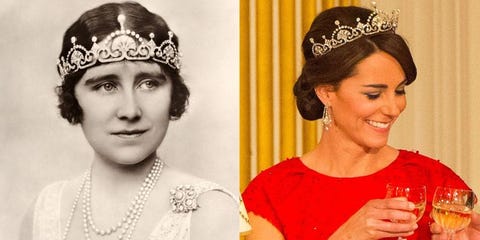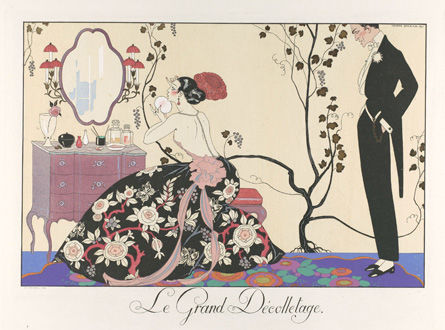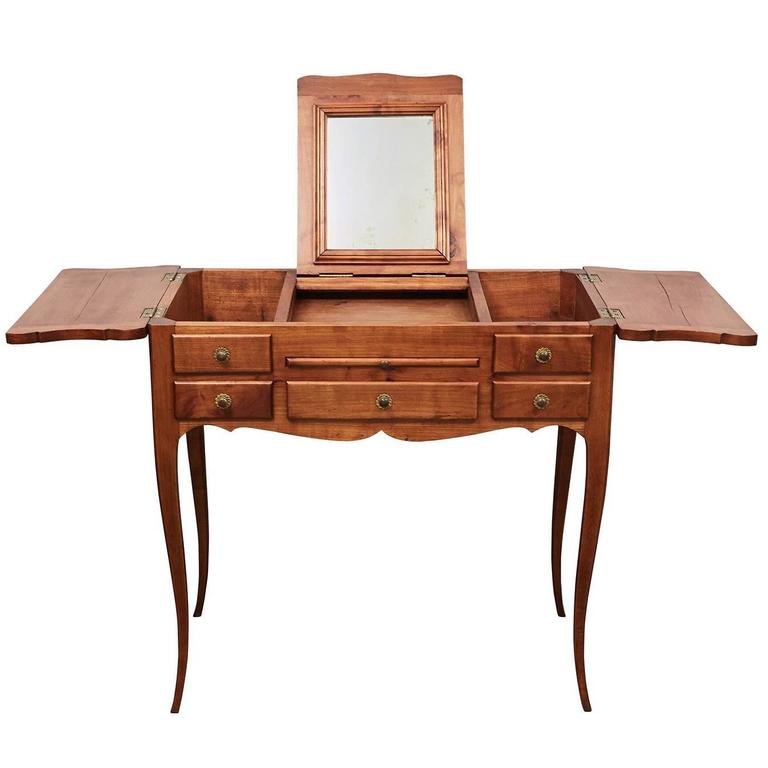talkingfashion » talkingfashion blog
-
The Heady History of the Hand Fan
The Heady History of the Hand Fan
By Paige McKirahan
When considering all of the accessories that are used for both utilitarian and decorative purposes, one of the first to come to mind is that of the hand fan. Though this ornamental piece was widely popular in Victorian Eras as a foreign symbol of wealth and class, their origin lies centuries prior in ancient Egypt, Greece, and Rome. After two elaborate fans were discovered in King Tut’s tomb, their gilded appearance solidified the fan’s prominent presence in the accessory world.

(photo credits to pinterest.com)
The fan, which was originally thought be a sacred instrument, was used in religious ceremonies and by royalty in noble settings. They were also used in China in association with ancient mythical and historical characters. At their conception, they were fixed and remained as so until Chinese culture birthed the folding fan and spread it westward towards Europe. Both Chinese and Japanese legends credit their respective countries with creating the piece; the Japanese feel that the folding style is modeled after the wings of bat, and the Chinese legend claims the idea stemmed from a woman fanning her face at a festival.

(photo credits to clickpicx.com)
The 17th century then saw an increase in the use of folding fan, eventually causing fixed fans to become obsolete. This style was brought to Western cultures by merchant traders and religious missionaries, and prompted the development of the printed fan, which was made available to all classes. They generally featured prints of all kinds, either painted or transferred on, and shifted from biblical tradition to contemporary pastimes. The Impressionist, Art Nouveau, and Art Deco movements highly impacted the design and construction of fans from the 19th to the 20th century . The 19th century boast some of the most lavish fan designs in history and they were usually hand painted, furnishing those in royal positions. In the 20th century, feathered fans became popularized by those in high society and ostrich plums could be see floating through the air at every Moulin Rouge show!
Even though fans are not presently part of the everyday fashionista’s accessory arsenal, they still can be seen at royal events and in haute couture shows. We here at TalkingFashion think that something so grand should never go out of style, so to get your own fashionable fan, check out our fantastic collection here!
Sources:
History of Fans. (n.d.). Retrieved from https://www.thefanmuseum.org.uk/fan-history
A Brief History of the Hand Fan. (2008). Retrieved from https://web.ics.purdue.edu/~salvo/@SEA/exhibit/history.asp
-
Headpiece Heaven: Five Fabulous Ornamental Accessories
Headpiece Heaven: Five Fabulous Ornamental Accessories
By Paige McKirahan
When it comes to the evaluation of headwear as an accessory rather than something worn out of necessity, it can truly make or break an outfit. Adding a scarf or hat to compliment a piece is customary, but what about more lavish head ornaments that are typically sported by royalty or those strutting the red carpet? Read on to learn about hair and head ornaments that emulate opulence from the top down!
This eclectic headwear is a more decorative alternative to the hat. Its roots can be traced back the Renaissance where it was customary for Christian women in Europe to sport head coverings. The use of the term came into circulation to describe the evolutionary form of this headpiece towards the end of the 20th century. Presently, it is typically worn at events where hats are customary and is accompanied by formal attire. They are commonly worn by woman as a covering during church services, weddings, or horse racing events. They are seen in great volume at royal events and Princess Beatrice of York wore a piece to Prince William and Catherine Middleton’s wedding that was so unusual, it became an internet sensation!
Tiara:
A tiara is a specific type of crown that tends to be bejeweled and ornamental in style. Appropriate for formal occasions of the white tie variety, this headpiece originates in Persia as a status symbol. The use of tiaras in ancient times declined with the rise of Christianity, but they saw a revival in the 18th century when Neoclassicism popularized the accessory for female adornment. Despite the fact that this revival was geared toward royalty, this piece has also been worn by wealthy commoners. The style is popular in the costume jewelry industry where they are worn by women for special occasions including homecomings, proms, quinceaneras, pageants, or weddings.

(image credits to harpersbazaar.com)
Hairpin:
The hairpin can come in many forms, but its basic function remains the same: to hold one’s hair in place. Whether the piece is elaborate and ornamental or utilitarian like a bobby pin, they are essential in creating different hairstyles. Coming from ancient Egypt and China, they were worn by all genders and were essential to hairstyling. They can also be used to note one's social or marital status. Now, they have a more decorative appearance and can be in the form of a barrette, bobby pin, or classic long straight pin.

(image credits to pinterest.com)
This hair accessory can be considered a variation of the hairpin; it is decorative and functional, with its main purpose being to hold a hat to the head. It was invented in Britain in the early 1800s and after its conception, the demand grew so great that a machine was created so it could be mass produced. In the late 1800s, bonnets became widely more circulated than hats, forcing hairpins into the closets of millions. They continued growing in popularity until the early 1900s until women began using them for self-defense purposes. They then began being regulated and their length decreased in order to deter wearers from using them as weapons.
Crown:
As the most traditional of headpieces on this list, the crown is a symbolic headwear typically won by royals. They represent power, victory, honor, glory, and legitimacy, and are often emblematic of the monarchy. These pieces can feature natural motifs, and they often are adorned with an assortment of expensive jewels. There are a variety of crown types and they can be used in coronations, at state occasions, or during weddings. You can even find their style being copied for novelty events (think Burger King's kid crowns!)

(image credit to us.hellomagazine.com)
Has Megan Markel and Harry's wedding got you feeling headpiece crazed? We can sate your desire for this royal glamour from the top down! Take a look at our collection to find headpieces for every occasion!
-
Dazzling Dressing Tables: A Brief History of the Vanity
Dazzling Dressing Tables: A Brief History of the Vanity
By Paige McKirahan
Though the world of luxury furniture is very much alive and well, the type of pieces we see popularized now are worlds away from the specially crafted styles that previously dominated the market. If you are someone with cosmetics, accessories, or perfumes, it is likely that you have some sort of container to hold them all (or so we hope!). But, we ask, have you ever stored them in an ever-so-glamorous vanity?
The dressing table is one piece of furniture that reveals a great deal about the culture in its time; few other items tell us more about leisure pursuits, trends, and changing social customs than this. This is an ever evolving piece and it has held a variety of names including the dressing table, dressing stand, vanity, and toilet table. But, we wonder, where did this fashionable furniture come from and how did it achieve the elegant status is possesses today?

(photo credits to the metmuseum.com)
Of course, the vanity comes from humble beginnings in ancient culture; its earliest ancestor is considered to be ornate boxes that were crafted for holding beauty products in Egypt and Greece. The use of boxes for this storage purpose continued for centuries until the 1600s in Europe, where the early vanity began evolving. The original name of the piece was the toilet table and they were used in the bathroom for hygiene purposes with a wash basin for freshening up. High society in this century and into the next began wanting more delicate designs; they started commissioning specialized furniture pieces that were modeled after shaving tables, poudreuses, and the low boy. Poudreuses hailed from France; they boasted a small tabletop for holding perfume, along with a small amount of drawer storage for makeup. Low boys were more so popular in the U.S. and England and were often custom made. In addition to their decorative elements, they typically offered one or two rows of drawers for storage purposes.


Poudreuse (top) and Low boy vanity styles
(photo credits to pinterest.com)
As we headed towards the 19th century, these tables started to become larger with more decorative features. They now included mirrors and an increased number of drawers, making them a more cabinet-style. With their newfound function, they began being included in bedroom furniture collections and were commonly accompanied by a small stool. The variety of styles offered also increased in this century; colonial, Queen Anne, and Chippendale style vanities were elaborate and were often made of oak, walnuts, or mahogany. We saw huge art movement influence on these tables and many revivalist styles including Gothic, Elizabethan, Rococo, and Renaissance.
19th Century Rococo Vanity
(photo credits to inessa.com)
The early 20th century brought the Art Deco movement alive; this artistic style is synonymous with the 1900s rise of the vanity as luxurious dressing tables became the epitome of prestige. Old Hollywood films of the ‘20s and ‘30s painted a picture of a femme fatale sitting in her Manhattan apartment decorated with an elegant vanity table. Since then, vanity table's luxurious standing still prevails with influencers and couture queens alike creating entire rooms surrounding their vanity space. Do you have a vanity you are looking to fill! Well say goodbye to those empty drawers and hello to our collection for a solution any accessory lover would adore!
-
Figural Accessories (And Why We LOVE Them)
Figural Accessories (And Why We LOVE Them) by Morgan Watkins
For fashion lovers across the world, accessories add a bit of joy and pizazz to everyday life. It’s not a coincidence that women adore receiving handbags and jewelry as gifts: accessories make people happy. But out of all the jewelry out there that could make a girl smile, figural jewelry is at the top of the food chain. With their cooky shapes and fun motifs, figural accessories are the perfect way to spice up any dull outfit. Keep on reading to get the lowdown on these fun fashion pieces.Although figural jewelry has been created since man first began constructing jewelry during B.C. times, it was around the 1940s that figural jewelry reached vast popularity among the masses. Accessories became a way of accessing happiness in otherwise dark times, as The Great Depression had just run its course and World War II was at its heyday. Thus as a means to inject a bit of sparkle and sunshine into the mundane, downcast nature of everyday living, figural jewelry was a great fashion escape.

(Image from https://talkingfashion.net/products/starfish-figural-sparkling-sea-hair-pin-accessory)
For those who are still a bit unsure about what figural jewelry and accessories are, they’re basically pieces that depict figures such as animals, human shapes, fruit, flowers, and more. The most common form of figural jewelry is the brooch or pin, but necklaces, bracelets, and rings are also apart of the figural family. These whimsical pieces can be fashioned with all kinds of materials, ranging from sterling silver floral pins dazzled with multicolored gems to simple copper rings topped off with beaded strawberry shapes.

(Image from https://talkingfashion.net/products/whimsical-watermelon-fruit-novel-approach-pink-gree n-figural-wooden-handcrafted)
Bringing the witty, fantastical fun of figural accessories into the modern world is notable and revered designer Betsey Johnson. Most famous for her out of this world handbags, Betsey is a vintage goddess designing for the most fearless women in fashion, including the likes of Katy Perry, Rachel McAdams, and Taylor Swift. Her bags have come in a gaggle of varying shapes, colors and sizes, ranging from bright pink flamingo crossbodies to typewriter inspired shoulder bags. Johnson keeps an air of magical whimsy both in stores and on the runway, finishing off her shows with spontaneous cartwheels that are as gleeful as her designs.

(Image from https://wanelo.co/p/32633388/betsey-johnson-typewriter-satchel-dillards)
DORIAN Designs, also known for producing wild figural jewelry in the 1980s, creates animal inspired pieces that are sure to pique the interest of any animal lover. The brand’s vintage accessories are greatly detailed, hand-carved and hand-painted to perfection. Animals like horses, bears, and leopards (oh my!) swing from cord to create necklaces of novelty and amusement. As perfect conversation starters with great personality, DORIAN Designs’ necklaces have you covered for figural jewelry with a bark that’s as fierce as its bite.

(Image from https://talkingfashion.net/products/dorian-designs-whimsical-figural-horse-necklace-han dpainted-wood-large-figural-authentic-vintage-jewelry-signed-collectible-talkingfashion-1 )
With endless possibilities stemming from figural jewelry, there truly is something for everyone. You can show off your love for animals, rep your admiration for gardening, and even sport your fascination with cars: all you have to do is find your perfect piece and rock it like its 1940. For the best of the best in figural accessories, or to sell your own novelty vintage jewelry, check out talkingfashion.net!

(Image from https://talkingfashion.net/products/sailboat-sailing-sea-boat-figural-pin-brooch-whimsical -orange-large-pewter-gold)
-
Designer Spotlight: Angela Caputi
Designer Spotlight: Angela Caputi
By Paige Mckirahan

(photo credits to advancingwomenartists.com)
This week, we figured that it would only be appropriate to spotlight one of our favorite Florentine designers, Angela Caputi, as she is a lover of the cross motif. Working out of a small shop in the historical "Palazzetto Mediceo", this bijoux aficionado has been creating pieces reminiscent of 1940s American Hollywood since 1975. Her brand quickly became popularized in the world of couture costume jewelry, catching the eyes of consumers, museums, and high fashion stylists alike. These pieces of art are heavily researched and always evolving; her signature style involves pieces that are created using simple materials with a variety of curated colors and shapes. In her domination of the global market, her creations have seen many movie sets and high fashion shoots since the brand's conception. Interested in owning one of her awe-inspiring bijoux artworks, click here to see what we have to offer! For more on her story, we invite you to visit her website.
Sources:
Angela Caputi: History. (2015). Retrieved from http://www.angelacaputi.com/en/history/











